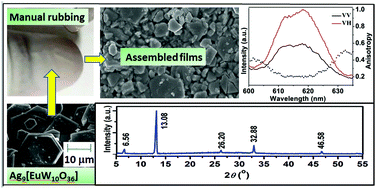Manual assembly of a rare-earth polyoxometalate microcrystal film showing highly polarized luminescence†
Abstract
Currently, the realization of rationally designed architectures based on polyoxometalates (POMs) with designed functions has mostly been achieved through the preparation of functional films. However, the traditional approaches suffer from the drawbacks such as time-consuming processes, ill-defined structure and quality, random orientation of the POM molecules, and unsatisfactory performance. In this study, microcrystals of Ag9[EuW10O36]·36H2O (denoted as Ag9[EuW10O36]) were synthesized via a titration method by treating Na9[EuW10O36]·32H2O (denoted as Na9[EuW10O36]), selected as a prototype, with Ag+, leading to the formation of a water-insoluble crystalline powder with a uniform hexagonal platelet morphology. After this, a simple yet efficient manual assembly method was used to rapidly manufacture Ag9EuW10O36 microcrystal thin films on a glass substrate with high coverage, high crystallinity, and highly preferential orientation. Note that the as-prepared films emit orange polarized fluorescence with an anisotropy value of about 0.21, which places them among the materials of largest anisotropy. It is expected that the manual assembly approach can be generally adopted for the fabrication of many other kinds of polyoxometalate-based materials on various substrates for practical applications.


 Please wait while we load your content...
Please wait while we load your content...